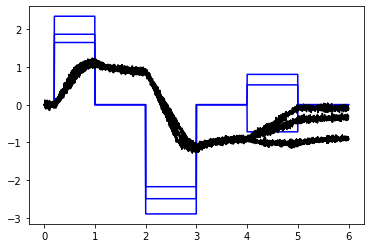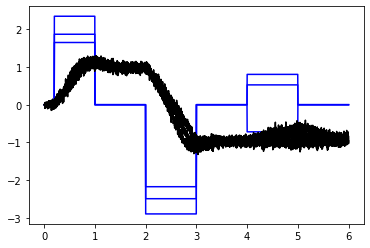- Overview
- Installation
- Configuration
- Example models
- Communication channel
- Integrator
- Multidimensional integrator
- Simple oscillator
- Nonlinear oscillator
- Neuron to neuron connections
- PES learning
- Keyword spotting
- MNIST convolutional network
- CIFAR-10 convolutional network
- Converting a Keras model to an SNN on Loihi
- Nonlinear adaptive control
- Legendre Memory Units on Loihi
- DVS from file
- API reference
- Tips and tricks
- Hardware setup
Multidimensional integrator¶
This demo implements an N-dimensional neural integrator.
This example utilizes a recurrent network. It shows how neurons can be used to implement stable dynamics. Such dynamics are important for memory, noise cleanup, statistical inference, and many other dynamic transformations.
It employs the EnsembleArray network, which provides a convenient method to act on multiple low-dimensional ensembles as though they were one high-dimensional ensemble.
[1]:
import matplotlib.pyplot as plt
%matplotlib inline
import numpy as np
import nengo
from nengo.networks import EnsembleArray
from nengo.processes import Piecewise
import nengo_loihi
nengo_loihi.set_defaults()
Creating the network in Nengo¶
Our model consists of one recurrently connected ensemble array, and an input node for each dimension. The input nodes will provide piecewise step functions as input so that we can see the effects of recurrence.
[2]:
dimensions = 3
tau = 0.1
with nengo.Network(label="Integrator") as model:
ens = EnsembleArray(n_neurons=100, n_ensembles=dimensions)
stims = [
nengo.Node(
Piecewise(
{
0: 0,
0.2: np.random.uniform(low=0.5, high=3.0),
1: 0,
2: np.random.uniform(low=-3, high=-0.5),
3: 0,
4: np.random.uniform(low=-3, high=3),
5: 0,
}
)
)
for dim in range(dimensions)
]
for i, stim in enumerate(stims):
nengo.Connection(stim, ens.input[i], transform=[[tau]], synapse=tau)
# Connect the ensemble array to itself
nengo.Connection(ens.output, ens.input, synapse=tau)
# Collect data for plotting
stim_probes = [nengo.Probe(stim) for stim in stims]
ens_probe = nengo.Probe(ens.output, synapse=0.01)
Running the network in Nengo¶
We can use Nengo to see the desired model output.
[3]:
with nengo.Simulator(model) as sim:
sim.run(6)
t = sim.trange()
0%
0%
[4]:
def plot_decoded(t, data):
plt.figure()
for stim_probe in stim_probes:
plt.plot(t, data[stim_probe], color="b")
plt.plot(t, data[ens_probe], "k")
plot_decoded(t, sim.data)

Running the network with NengoLoihi¶
[5]:
with nengo_loihi.Simulator(model) as sim:
sim.run(6)
t = sim.trange()
/home/travis/build/nengo/nengo-loihi/nengo_loihi/builder/discretize.py:477: UserWarning: Lost 2 extra bits in weight rounding
warnings.warn("Lost %d extra bits in weight rounding" % (-s2,))
[6]:
plot_decoded(t, sim.data)
